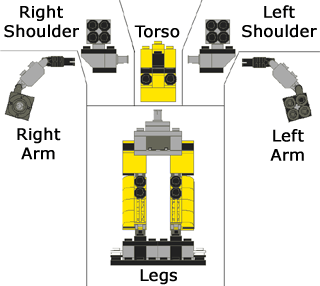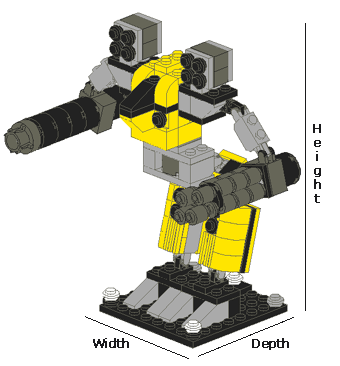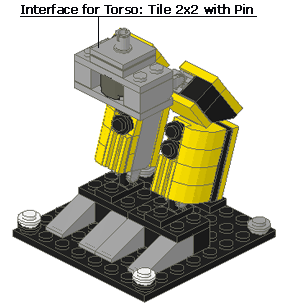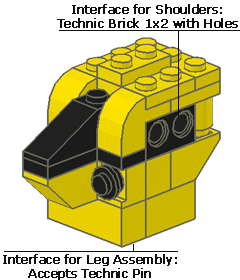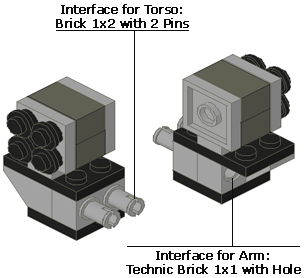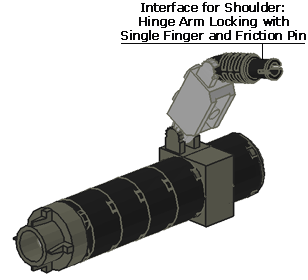|
|
|
Leg Assembly
Specifications:
The legs must be mounted on a Plate
8x8 base. No part of the legs may extend past the base. The legs must
be at least five bricks high, not counting the Tile 2x2 with Pin.
Interfaces:
- Torso:
To mate with the torso, the leg assembly must have a Tile
2x2 with Pin (or equivalent) at its top. No part of the legs may
extend above base of the pin.
|
|
|
|
Torso
Specifications:
The torso must be at least 3 bricks high and only 3 or 4 bricks wide.
It can be as deep as the designer wants but may not extend below the base.
Interfaces:
- Shoulders
(x2): To mate with the shoulders, the torso must have two Technic
Brick 1x2 With Holes*, one on each side. No part of the torso can
extend sideways farther than these pieces. There must be at least two
bricks' height in the torso below this piece.
- Leg assembly:
To mate with the leg assembly, the torso must accept a vertical Technic
pin in its base. This might be done with a brick, Technic plates, or
SNOT construction using a brick with a Technic hole
*To achieve an
offset, it is permissible to use a Technic
Brick 1x4 with Holes instead. The extra hole should be filled with
a Technic Pin
1/2 with the stud facing the inside (or similar) if possible so that
only one position is possible for the shoulder.
|
|
|
|
Shoulder
Specifications:
The shoulder must be 2 or 3 studs wide. It extend as many bricks up from
the torso interface as the designer wishes and can decend up to two bricks
below the torso interface--but no more, to allow the torso to turn freely.
It can extend in front or behind as far as the designer wants so long
as it won't overbalance a Mech.
The shoulder should
be built exclusively for the left or right side of the Mech, so that any
weapons mounted on it face the front of the Mech when attached to the
torso.
Interfaces:
- Torso:
To mate with the torso, the shoulder must have a Brick
1x2 with 2 Pins on one side. No part of the shoulder may extend
sideways past this part.
- Arm: To
mate with the arm, the shoulder must have one Technic hole on the opposite
side from the Brick 1x2 with 2 Pins. This interface may be higher or
lower than the torso interface but its depth must be within the Brick
1x2 with 2 Pins. This hole could be in a Technic
Brick 1x1 with Hole or a Technic
Brick 1x2 with Hole, among other possibilities. The shoulder may
extend sideways 1 stud past the Technic hole, as long as the hole itself
is not blocked.
|
|
|
|
Arm
Specifications:
The arm has no mandatory dimensions, but should be built so as not to
overbalance a Mech. The arm should be built exclusively for the left or
right side of the Mech, so that any weapons mounted on it face the front
of the Mech when attached proper-side-up to the shoulder.
Interfaces:
- Shoulder:
To mate with the shoulder, the arm must have a Technic pin (preferably
a friction pin) at its end. This pin must allow for free rotation in
a space no larger than a brick, so it should be provided on a Hinge
Arm Locking with Single Finger and Friction Pin, or as a Friction
Pin attached to something else narrow such as Technic
Axle Joiner, another Hinge Arm piece, or Technic
Pin Joiner.
|
